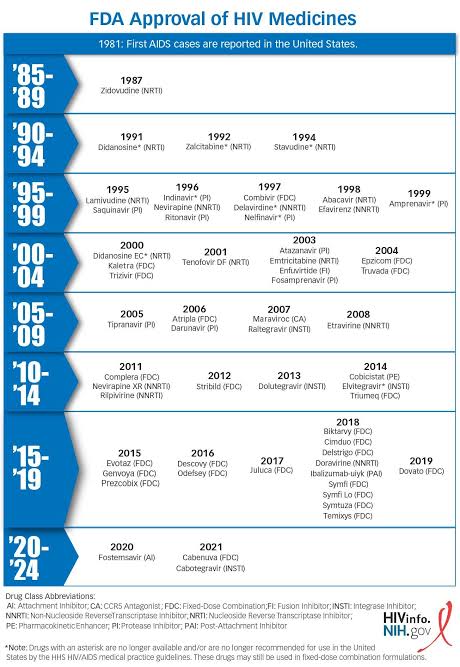Treatment for HIV Infection: Anti Retroviral Medicines and Their Classification and Side Effects and Contraindications.
HIV (Human Immunodeficiency Virus) is a virus that attacks the body’s immune system, making it more susceptible to infections and diseases we will review the treatment of HIV medicines Side Effects and Contraindications . Over the years, medical advancements have led to the development of various antiretroviral drugs that aim to control the progression of HIV and improve the quality of life for those living with the virus. The United States Food and Drug Administration (USFDA) has approved several medications for the treatment of HIV, and these drugs can be categorized into different classes based on their mode of action. In this article, we will discuss the different categories and newly FDA-approved HIV medications, their modes of action, side effects, and contraindications of Anti retroviral Medicines.
Categories of FDA-Approved HIV Medications:
Nucleoside/Nucleotide Reverse Transcriptase Inhibitors (NRTIs):
NRTIs act by interfering with the reverse transcription process of HIV, inhibiting the virus from converting its RNA into DNA. This prevents the virus from integrating into the host’s DNA and replicating further. Some examples of NRTIs in Anti retroviral Medicines include:
Zidovudine (AZT)
Tenofovir disoproxil fumarate (TDF)
Emtricitabine (FTC)
Abacavir (ABC)
Non-Nucleoside Reverse Transcriptase Inhibitors (NNRTIs):
NNRTIs directly bind to the reverse transcriptase enzyme, blocking its activity and preventing viral replication. Examples of NNRTIs include:
Efavirenz (EFV)
Rilpivirine (RPV)
Nevirapine (NVP)
Protease Inhibitors (PIs):
PIs target the HIV protease enzyme, which is essential for the virus to mature and become infectious. By inhibiting protease, these drugs prevent the release of new, infectious viral particles. Some examples of PIs are:
Atazanavir (ATV)
Darunavir (DRV)
Lopinavir/ritonavir (LPV/r)
Integrase Strand Transfer Inhibitors (INSTIs):
INSTIs block the integrase enzyme, which is responsible for inserting viral DNA into the host cell’s DNA. By inhibiting this step, the virus cannot integrate and replicate. Examples of INSTIs include:
Raltegravir (RAL)
Dolutegravir (DTG)
Elvitegravir (EVG)
Entry Inhibitors:
These drugs prevent HIV from entering the host cell by targeting different viral proteins. The two main classes of entry inhibitors are:
Fusion Inhibitors (e.g., Enfuvirtide)
CCR5 Antagonists (e.g., Maraviroc)
Mode of Action of antiretroviral medicines:
Each class of HIV medication targets a specific step in the viral lifecycle, aiming to prevent replication and reduce viral load in the body. By doing so, these drugs help preserve the immune system and slow down the progression of HIV to AIDS.
Side Effects of Anti retroviral Medicines:
While antiretroviral medications are crucial for managing HIV, they can also cause side effects. These side effects vary depending on the specific drug and the individual’s response to treatment. Common side effects may include:
Nausea and vomiting
Diarrhea
Fatigue
Headache
Rash
Elevated liver enzymes
Lipodystrophy (changes in body fat distribution)
It’s important to note that not everyone experiences these side effects, and some individuals may have few or no adverse reactions to their prescribed medications.
Contraindications:
Certain medical conditions and drug interactions can contraindicate the use of specific HIV medications. For instance:
Abacavir should not be used in individuals with a known hypersensitivity to it, as it can cause a severe allergic reaction.
Rilpivirine should be avoided in patients with a high viral load or a history of treatment failure.
Some drugs may interact with antiretrovirals, potentially leading to reduced efficacy or increased toxicity. Therefore, it’s crucial for healthcare providers to review patients’ full medical history and current medications before prescribing HIV treatments.

Referances: https://hivinfo.nih.gov/understanding-hiv/
Leave a Reply